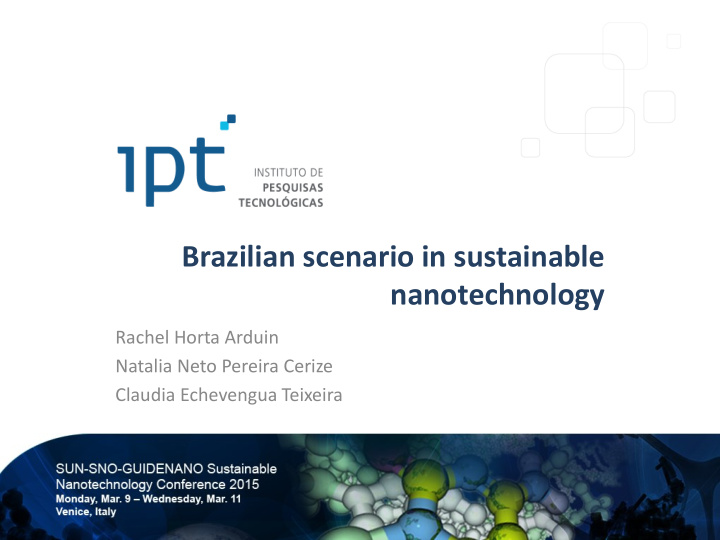



Brazilian scenario in sustainable nanotechnology Rachel Horta Arduin Natalia Neto Pereira Cerize Claudia Echevengua Teixeira
IPT – Institute for Technological Research One of Brazil’s largest research institutes. Eleven technology centers acting multidisciplinarily in a broad range of fields.
Nanotechnology in Brazil Since the 2000’s | National program to develop and disseminate nanotechnology. Investments of the Brazilian government and private sector. 2006| Brazil was the 25th country in the world ranking of publications in this field. 2014| Brazil joined Nanoreg.
Nanotechnology in Brazil Brazilian Agency for Industrial Development (ABDI) Sector reports 2010 Evaluation of the scientific production in Brazil related to toxicity, safety and risk assessment of nanotechnologies from 1999-2008 Search platform: Web of Science
Nanotechnology in Brazil Table 1: Scientific production in Brazil related to toxicity, safety and risk assessment of nanotechnologies (1999-2008) Risk Subject Total Toxicity Safety Assessment Nanoparticles 1038 27 0 0 Nanotubes 519 3 0 0 Nanostructures 313 0 0 0 Quantum dots 429 0 0 0 Nanocrystals 291 0 0 0 Nanocomposites 303 0 0 0 Fullerenes 56 0 0 0 Nanomaterials 44 0 0 0 Nanospheres 63 6 0 0 Engineered 0 0 0 0 nanomaterials ABDI (2010)
Nanotechnology in Brazil 2011 Lack of data in Brazil related to nanosafety. Necessity of encourage studies related to risk assessment (human health and environment). 2013 Concept of life cycle impact. Presentation of an algorithm for classifying a product as a nanomaterial.
Goal General Goal| Evaluate the scientific production related to sustainable nanotechnology in Brazil. Main Goal| Identify LCA studies in order to evaluate the scope of the studies and methodology details. IPT and Sustainable Nanotechnologies Include the evaluation of the environmental performance (LCA) of nanoproducts developed by the Institute.
Method Systematic literature review Period: until December 2014 Establishment of keywords: English and Portuguese Selection of search platforms: Journals, Conference papers and thesis The works were classified into sustainable nanotechnology and life cycle assessment. Sustainable nanotechnology: presents a discussion regarding the effect of the nanomaterials in the environment. Life cycle assessment: LCI and LCA studies
Results Literature highlights that after 2010 the discussion regarding the environmental impacts of the nanotechnology has increased. 6 5 Sustainable 4 Nanotechnology 3 LCI 2 LCA 1 0 2005 2007 2010 2011 2013 2014
Results Sustainable Nanotechnology Goal/Discussion of the authors Potential environmental impact of nanomaterials. Characteristic of the nanoparticles can facilitate its dispersion into the environment. Particle size is just one of the factors defining the effects. Routes of exposure, access and distribution of nanomaterials in the environment. Greater concern with the inhalation of nanoparticles.
Results Sustainable Nanotechnology Importance of characterize, quantify and evaluate the toxicity of the nanomaterials. Necessity of standardized toxicological tests for nanomaterials. Toxicological and biodegradation data on nanoparticles are scarce, although there are commercial products on the market.
Results Life Cycle Inventory 2010. CAVALCANTE et al. Nanomaterial| Cellulose nanocrystals from coconut fibers Functional unit| 1g of nanocrystals from coconut fiber Boundaries| Milling, washing, bleaching and sulfuric acid hydrolysis Environmental aspects quantified Water Energy Emissions to water (BOD, COD)
Results Life Cycle Assessment Nanomaterials| cellulose nanowhiskers obtained from tropical vegetal fibers Cotton (2) Coconut (2) Sugarcane bagasse (2). Functional unit| g of cellulose nanowhisker. Boundaries From agriculture production to extraction of the nanowhiskers.
Results Life Cycle Assessment Data quality Primary data: agriculture production in Brazil and extraction of nanowhiskers. Ecoinvent database. Method| ReCiPe Midpoint H Impact categories Eutrophication (2) Human toxicity (3) Ecotoxicity (2) Climate change (2) Acidification (1)
Conclusions The environmental aspect was usually discussed in the field of risk assessment, but few studies aimed to quantify the impacts. LCA studies performed by EMBRAPA Cradle to gate and focused in the inventory of the production of the nanomaterial in Brazil. Cellulose nanowhiskers have great potential to reinforce the mechanical properties of different polymers and their production is expected to grow in near future.
Conclusions LCA as a methodology to evaluate the impact and to help decision making Selection of materials Comparison of process Little emphasis has been given to the use and end of life phases. LCA can help identify opportunities for reducing environmental impacts in the entire life cycle of nanoproducts.
rachel@ipt.br
Recommend
More recommend